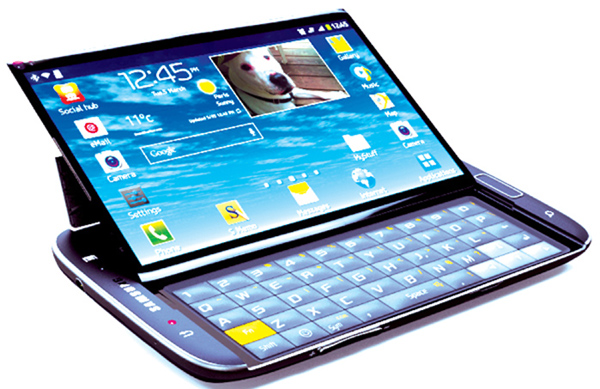Neeraj Dubey
Phablet is a combined term Smartphone and Tablet, is a class of smart phones that has a screen size between 5 and 8 inches and is designed to incorporate or complement the functions of smart phones and tablets. Tablet is a gadget that has a touch screen interface, and usually measuring 8.9 to 10 inches. Examples such as iPad, Samsung Galaxy Tab, Motorola Xoom and the like. While smartphone or modern telephone, is to feature a Phone call, SMS, Web browsing and so on. Usually have varying screen sizes, from 3 inches to 5 inches. For example Samsung Galaxy Mini, Motorola RAZR and similar products. Phablet is a term commonly used to describe a gadget that combines the capabilities of smartphones and tablets. Phablet usually larger than a smartphone, but smaller than a tablet. The term “Phablet” was first used at the site on Engadget technology and Forbes. Although larger than a smart phone, phablet tend to be smaller and thinner than the tablet, making it convenient to carry or bagged users. Phablet usually used for mobile web access and multimedia, including activities that require a large screen. In a series of Samsung Galaxy Note, phablet has special software that allows the stylus features sketches, and notes. Screen size varies between 5-7 inches. Phablet also has a feature that is owned by a smartphone such as voice calling, although the screen size of the tablet resembles. The device was first recognized as a Dell Streak phablet is coming out in the 2010s. In January 2013, IHS reported that 25.6 million phablet sold in 2012 and estimates that number will rise to 60.4 million units in 2013, and 146 million in 2016. In the analysis of 2013, Engadget saw a price drop screen, display increased energy efficiency, increased battery power and multimedia value change is a major factor in the popularity phablet. Samsung’s Galaxy Note series (Original, II, and 3 pictured) were the first commercially successful “phablet” devices. While Samsung’s Galaxy Note (2011) is largely credited with pioneering the worldwide phablet market when launched in 2011. In a 2013 analysis, Engadget identified dropping screen prices, increasing screen power efficiency, increasing battery life and the evolving importance of multimedia viewing as critical factors in the popularity of the phablet in 2012.
Phablets were originally designed for Asia and other emerging markets where consumers could not afford both a smartphone and tablet as in North America. However Phablets became successful in North America too for several reasons. Many older consumers preferred larger screen sizes on Smartphone’s due to deteriorating eyesight. Android 4.0 and subsequent releases were suited to large as well as small screen sizes. While many handset manufacturers were jumping on the trend of larger screen sizes to suit all niches, Apple (under the direction of Steve Jobs) had long refused to produce a device larger than the iPhone’s 3.5 inches or smaller than the iPad’s 9.7 inches until late 2012. While Apple’s iPad heavily dominated the tablet market, the void in their lineup left an opening for intermediate-sized devices such as phablets.
The Samsung Galaxy Note used a 5.3 in (130 mm) screen. While some media outlets questioned the viability of the device, the note received positive reception for its stylus functionality, the speed of its 1.5 GHz dual-core processor, and the advantages of its high resolution display. The Galaxy note was a commercial success; Samsung announced in December 2011 that the Galaxy Note had sold 1 million units in two months. In February 2012, Samsung debuted a note version with 4G LTE support, and by May 2012 the Note received an update from Android 2.3 to Android 4.0. By August 2012, the Note had sold 10 million units worldwide. The 2012 Samsung Galaxy Note II employed a 1.6 GHz quad-core processor, a 5.55 in (141 mm) screen and the ability to run two applications at once via a split-screen view. Sales of the Galaxy Note II reached 5 million units internationally in two months. In 2013, Nokia introduced phablets, the Nokia Lumia 1320 and Nokia Lumia 1520, both with 6-inch displays. Examples of phablets with screens surpassing 6 inches in size began appearing in 2013; with the Chinese company Huawei unveiling its 6.1 in (150 mm) Ascend Mate at Consumer Electronics Show, and Samsung introducing the Galaxy Mega, a phablet with a 6.3 in (160 mm) version (however, unlike the Galaxy Note line, it does not use a stylus). While unveiling the aforementioned Ascend Mate, Huawei CEO Richard Yu considered the phablet to be the future of smartphones due to their “all-in one” nature. As a matter of fact, phablets are commercially gaining some acceptance where stylus comes handy. Stylus makes it life-like when it comes to put a signature or simply note down stuffs.
Industries like Logistics, restaurants and retail can be thought as a few of the targeted niche industries for the phablets makers. With not much to differentiate a phablet yet from a bigger smartphone or a smaller tablet with calling feature, it ends up being a personel choice in the hands of the buyers.
But still Phablets pose not much threat to the Tablet PCs yet. Tablets have their own matchless stature, when it comes to utility. In various corporate structures, educational institutions and professions ( like doctors, engineering college professors and architects) where they require books and presentations up and ready all the time; Tablets still make to the most favorite resource.
(The author is Sr. Asstt Professor GCET, Jammu)
Trending Now
E-Paper


